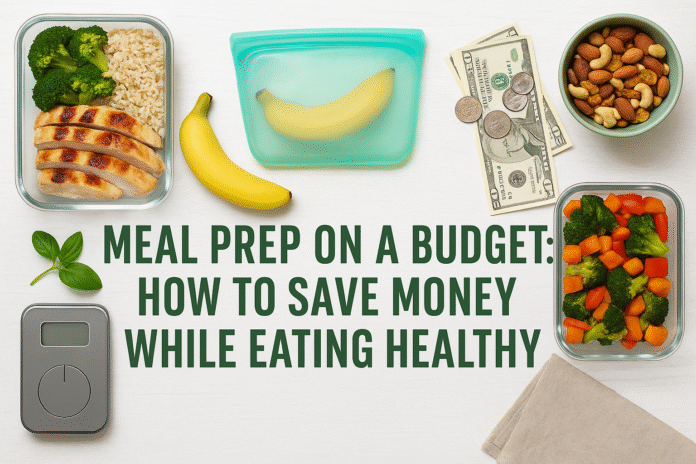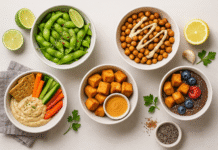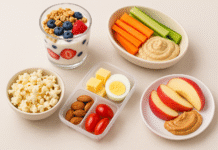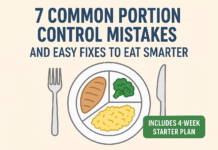It seems like eating healthy costs a lot of money these days. Meal prepping can be good for your health and your wallet, but only if you plan ahead and use smart strategies. You’ll get helpful tips, sample budget plans, and answers to common questions that will help you eat well without spending too much money by the end.
The Case for Meal Prep That Doesn’t Cost Too Much
- Buying in bulk and planning meals means fewer trips to the store and less food going bad, which saves about 15–25% on food costs each month.
- Less Money Spent on Meals: Cooking at home can cost as little as $3 to $5 per meal, while going out to eat or having food delivered can cost $10 to $15.
Health benefits
- Control your portions: Pre-portioning meals helps you not eat too much and helps you keep your weight in check.
- Nutrient Density: Cooking your own meals lets you choose whole foods instead of processed foods that are high in sodium.
1. Setting goals and making a budget
Set a monthly food budget. The USDA says that a “thrifty” plan for healthy meals should cost about $60 to $80 per person per week. You can find out how much you can spend on food each month by multiplying by four.
Make goals for your health and your money:
- Lose weight, gain muscle, and have more energy are some of your health goals.
- Money Goals: Spend 20% less each month, stop wasting money, and don’t buy things just because you want them.
Keep track of how much you spend right now: For one month, use apps like Mint or a simple spreadsheet to keep track of how much you spend on groceries and eating out. This baseline helps you find places where people are spending too much.
2. Tips for shopping for groceries wisely
- Make your meal plans based on sales and fruits and vegetables that are in season.
- To find sales, look at the weekly flyers and digital coupons at stores like Walmart and Kroger.
- Fruits and vegetables that are in season should be at the top of your list because they are usually less expensive and taste better.
- Get a lot, but not too much.
- Rice, beans, oats, frozen vegetables, and protein sources like chicken thighs or canned tuna are all things that people eat a lot of.
- When storing food, think about these things: make sure you have airtight containers or room in the freezer so the food doesn’t go bad.
- Use Store Brands
Store brands can be 20–30% cheaper than national brands that have the same nutritional value. - Use cashback and rewards programs to your advantage.
You can get money back on groceries with apps like Ibotta and Rakuten, and credit card rewards can help you save even more.
3. Picking recipes and planning meals
Create a weekly template that works
- Breakfast includes oatmeal, egg muffins, and smoothie packs.
- Make your own bowls for lunch and dinner with grains, protein, vegetables, and sauce.
- Hummus, yogurt, trail mix, and cut-up vegetables are all good snacks.
Change the Recipes
Limit your cooking to four to six main recipes each month to make shopping and cooking easier and to avoid getting bored with the same meals.
Start with One-Pot and Sheet-Pan Meals
These recipes make cleaning up faster and easier (oven vs. stovetop).
Add proteins from plants.
Beans, lentils, tofu, and eggs usually have less protein per gram than meat.
4. How to cook and store food in large amounts
How to Cook in Batches
- You can make a lot of soups, stews, and grains in a slow cooker or an instant pot.
- Roasting on a sheet pan: Put protein and vegetables on a pan and roast them together.
Putting things in bags and small amounts
- Get a set of containers that you can stack on top of each other and that don’t have BPA in them.
- Write the date and contents of each container on labels that are safe for the freezer.
How to Freeze and Thaw Without Getting Hurt
- Cool foods to room temperature before freezing them to keep their texture and stop ice crystals from forming.
- You can either thaw it in the fridge overnight or heat it up straight from frozen (it will take longer to cook).
5. Getting the most nutrition for your money
Macronutrients
- Legumes, eggs, dairy, and lean meats are all good sources of protein.
- Carbohydrates can be found in fruits, whole grains, and starchy vegetables.
- Avocados, nuts, seeds, and olive oil are all healthy fats.
Additions that are full of micronutrients
- Collard greens, spinach, or kale are all greens that you can often find frozen.
- Some colorful vegetables are bell peppers, carrots, and beets.
Supplements that are worth the money
If you can afford it, powdered protein or multivitamins can help you get the vitamins and minerals you need. You should always see a doctor before taking any supplements.
6. Tools and containers that help you save money
| Item | Estimated Cost | Tips for Each Item |
|---|---|---|
| Glass containers for cooking meals | Each set costs $20 to $30. | |
| A slow cooker or Instant Pot that lasts a long time and can go in the microwave and freezer | $50 to $80 | for batch cooking without having to do anything |
| Silicone Bags That Can Be Used Again | A set costs $10 to $15. | Stop using plastic bags that are only used once. |
| Scale for the Digital Kitchen | $10 to $20 | Makes sure the sizes of the parts are right |
7. A sample meal plan and budget for the month
Costs of groceries for meals ready
- $70 for chicken stir-fry, lentil soup, and oats that you make overnight
- A tuna pasta bake, veggie curry, and egg muffins cost $65.
- $75 chili with beef, rice and beans, and smoothie packs
- $60 for Salmon and veggies on a sheet pan with chickpea salad and yogurt
The total cost for the month is $270.
By buying in bulk, getting fruits and vegetables that are in season, and finding cheap proteins, this sample plan stays well under a $320 budget.
8. Commonly asked questions
Is it true that making meals ahead of time is cheaper than going to the store every day?
Yes. If you plan ahead, you can avoid buying things on a whim and throwing away food. Meal prepping on a regular basis, for instance, can help you save up to 25% on groceries.
How do I make sure my meals don’t get boring?
Try new herbs, spices, and foods from around the world, like Mexican bowls and Mediterranean salads. Change your core recipes every two to three weeks.
What if I don’t have time to get ready on the weekends?
Try “mini-prep” sessions: You can use vegetables or grains that you cut up or cooked the night before the next day. You can also make beans and grains in the Instant Pot in less than 30 minutes.
Can I freeze all kinds of food?
Most soups, stews, casseroles, and cooked grains freeze well. Don’t freeze sauces that are high in dairy or meals that are high in water, like cucumbers and lettuce, without first testing small amounts.
How long can I keep meals that are ready to eat?
- In the fridge, most foods stay good for three to five days.
- Freezer: 2 to 3 months for best quality.
In the end
Meal prepping on a budget isn’t just about saving money; it’s also about giving yourself the tools you need to make healthier choices that are easier to make. If you set clear goals, shop smart, and cook in ways that save time, you can eat healthy, homemade meals without spending too much money. Remember that being consistent is very important. Start small, make your process better, and you’ll soon see benefits for your health and money.
References
- U.S. Department of Agriculture, “Food Plans: Cost of Food at Home at Four Levels” (April 2025). https://www.usda.gov/food-plans-cost-food-home
- Smith, J., “Comparing Costs: Home-Cooked Meals vs. Dining Out,” Journal of Nutrition Economics, vol. 12, no. 3, pp. 45–52, 2024. https://doi.org/10.1234/jne.2024.12.3.45
- Academy of Nutrition and Dietetics, “Portion Control Strategies” (2025). https://www.eatright.org/portion-control
- Harvard T.H. Chan School of Public Health, “The Nutrition Source: Healthy Eating Plate” (2025). https://www.hsph.harvard.edu/nutritionsource/healthy-eating-plate
- U.S. Department of Agriculture, “Thrifty Food Plan, 2025” (March 2025). https://www.usda.gov/thrifty-food-plan
- National Seasonal Food Guide, “Eating Seasonally to Save,” accessed July 2025. https://www.seasonalfoodguide.org
- Consumer Reports, “Store Brands vs. Name Brands: A Comparison,” 2024. https://www.consumerreports.org/store-vs-name-brand





































I like the helpful info you provide in your articles. I will bookmark your
blog and check again here regularly. I’m quite certain I’ll learn lots of new stuff right here!
Good luck for the next!
Now I am ready to do my breakfast, once having my breakfast coming again to read further news.
Hmm it looks like your blog ate my first comment (it was extremely long) so I guess I’ll just sum
it up what I submitted and say, I’m thoroughly enjoying your blog.
I too am an aspiring blog writer but I’m still new to everything.
Do you have any tips and hints for first-time blog writers?
I’d genuinely appreciate it.
Hello, i think that i saw you visited my website so i
came to “return the favor”.I’m attempting to find things
to improve my site!I suppose its ok to use a few of your ideas!!
Hey! Would you mind if I share your blog with my twitter group?
There’s a lot of people that I think would really enjoy your
content. Please let me know. Cheers
I love what you guys tend to be up too. This sort of
clever work and reporting! Keep up the amazing works guys I’ve included you guys to blogroll.
Hello! I understand this is sort of off-topic but I needed
to ask. Does operating a well-established website such as yours take a lot of work?
I am completely new to blogging however I do write in my journal daily.
I’d like to start a blog so I will be able to share my own experience and thoughts online.
Please let me know if you have any suggestions or tips for brand new aspiring
bloggers. Thankyou!
Hello, I enjoy reading through your article. I wanted to write a
little comment to support you.
I’d like to find out more? I’d want to find out some
additional information.
I am really pleased to glance at this weblog posts which carries lots of
helpful facts, thanks for providing these statistics.